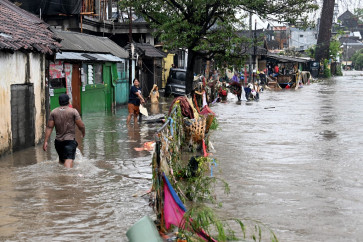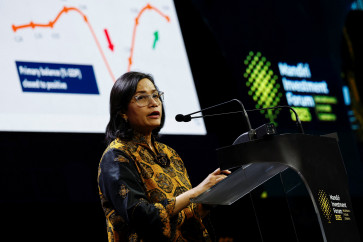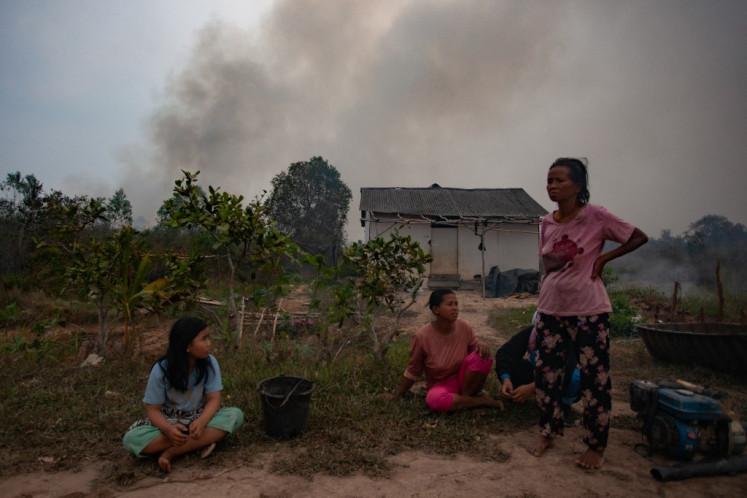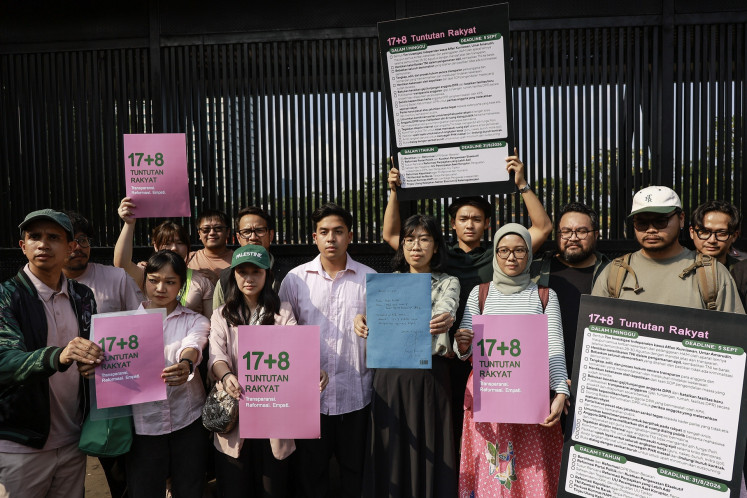Popular Reads
Top Results
Can't find what you're looking for?
View all search resultsPopular Reads
Top Results
Can't find what you're looking for?
View all search resultsThe art of coffee dregs
One mood color: Sawir expresses his concerns in brush strokes with a cup of coffee
Change text size
Gift Premium Articles
to Anyone
One mood color: Sawir expresses his concerns in brush strokes with a cup of coffee.
Coffee dregs that normally end up in garbage cans will be transformed in the hands of Sawir Wirastho, who uses the residue in his paintings to reflect the various realities of life.
“I can’t write stories, so I hope people will be able to grasp the messages conveyed by these paintings,” he said recently during his solo exhibition at the Sarinah Building in Malang, East Java.
Sawir noted that most communities have forgotten the ancestral legacy of visual literacy, such as temple reliefs, which were full of human values and knowledge.
“Through such visual messages, the process of understanding will be more profound,” emphasized the 41-year-old, who also fosters and provides shelter for street children in his home in Kepanjen district.
His recently completed solo exhibition presented various social phenomena. One of his paintings, Harapan Dan Persoalan Akar Rumput (Hopes and Grassroots Issues), is about minimum protection for society, portrayed by several women with folded umbrellas around them and several other women conversing.
“Umbrellas symbolize protection, but what often happens is various issues only turn into gossip [as they represent a threat],” said the father of two.
His longing for a peaceful rural atmosphere of the past was expressed in a picture he painted while enjoying a cup of coffee during the exhibition. Sawir has been painting with coffee dregs since 1999.
He said drinking coffee while smoking cigarettes is a tradition in his village, especially after the harvests. He has quit smoking but remained loyal to drinking coffee; he even owns a coffee stall.
“[…] I turned to paper sheets and canvases to create images,” the artist added.
Enchanted by the medium, Sawir learned more about how to make the coffee residue stick firmly to the canvas.
“Coffee as an organic material is highly vulnerable to fungi,” he pointed out.
Sawir Wirastho
After some experimenting, he discovered a method he considered most appropriate: sugarless coffee is stirred after being brewed for the first time, until its dregs settle for one to two minutes. The rough deposits are poured into a saucer and left to settle again for the same length of time, after which the most refined dregs are obtained for painting. To ensure the coffee residue will stick, a wood-glue coating is applied to the canvas.
Sadly, in 2009, the room in which Sawir stored his coffee paintings at home caught fire, destroying all his canvases.
“I stopped painting for three years, focusing only on my coffee stall and social activities,” he recalled.
The fine art graduate of Malang State University eventually regained his spirit to resume his abandoned profession in 2012. His new paintings illustrate his concerns over social problems faced by women and children. They have also been showcased in art exhibitions across the world.
“Thank God, I’ve been invited to exhibit in Kuwait this year, and I plan to join another show in Taiwan next year,” Sawir said.
Setting aside some of the proceeds of his paintings for orphans, Sawir follows the principle that kopi iso ngopeni (coffee enables people to share, maintain and provide comfort for fellow citizens).
The humble artist only created portrait-shaped frames, reasoning that his paintings only serve as prayers and vertical dialogues with God.
—Photos by Nedi Putra AW

![One mood color: Sawir expresses his concerns in brush strokes with a cup of coffee." width="780" height="624" border="0">One mood color: Sawir expresses his concerns in brush strokes with a cup of coffee.</p><p>Coffee dregs that normally end up in garbage cans will be transformed in the hands of Sawir Wirastho, who uses the residue in his paintings to reflect the various realities of life. <br><br>“I can’t write stories, so I hope people will be able to grasp the messages conveyed by these paintings,” he said recently during his solo exhibition at the Sarinah Building in Malang, East Java.<br><br>Sawir noted that most communities have forgotten the ancestral legacy of visual literacy, such as temple reliefs, which were full of human values and knowledge. <br><br>“Through such visual messages, the process of understanding will be more profound,” emphasized the 41-year-old, who also fosters and provides shelter for street children in his home in Kepanjen district.<br><br>His recently completed solo exhibition presented various social phenomena. One of his paintings, Harapan Dan Persoalan Akar Rumput (Hopes and Grassroots Issues), is about minimum protection for society, portrayed by several women with folded umbrellas around them and several other women conversing. <br><br>“Umbrellas symbolize protection, but what often happens is various issues only turn into gossip [as they represent a threat],” said the father of two. <br><br>His longing for a peaceful rural atmosphere of the past was expressed in a picture he painted while enjoying a cup of coffee during the exhibition. Sawir has been painting with coffee dregs since 1999. <br><br>He said drinking coffee while smoking cigarettes is a tradition in his village, especially after the harvests. He has quit smoking but remained loyal to drinking coffee; he even owns a coffee stall. <br><br>“[…] I turned to paper sheets and canvases to create images,” the artist added.<br><br>Enchanted by the medium, Sawir learned more about how to make the coffee residue stick firmly to the canvas.<br><br>“Coffee as an organic material is highly vulnerable to fungi,” he pointed out.</p><p><span class="inline inline-center"><img class="image image-img_assist_custom-780x634 " src="http://202.158.21.182/files/images2/19sawirr.img_assist_custom-780x634.png" alt="Sawir Wirastho" title="Sawir Wirastho" width="778" height="634" border="0"><span class="caption">Sawir Wirastho</span></span><br><br>After some experimenting, he discovered a method he considered most appropriate: sugarless coffee is stirred after being brewed for the first time, until its dregs settle for one to two minutes. The rough deposits are poured into a saucer and left to settle again for the same length of time, after which the most refined dregs are obtained for painting. To ensure the coffee residue will stick, a wood-glue coating is applied to the canvas. <br><br>Sadly, in 2009, the room in which Sawir stored his coffee paintings at home caught fire, destroying all his canvases.<br><br>“I stopped painting for three years, focusing only on my coffee stall and social activities,” he recalled. <br><br>The fine art graduate of Malang State University eventually regained his spirit to resume his abandoned profession in 2012. His new paintings illustrate his concerns over social problems faced by women and children. They have also been showcased in art exhibitions across the world.<br><br>“Thank God, I’ve been invited to exhibit in Kuwait this year, and I plan to join another show in Taiwan next year,” Sawir said. <br><br>Setting aside some of the proceeds of his paintings for orphans, Sawir follows the principle that kopi iso ngopeni (coffee enables people to share, maintain and provide comfort for fellow citizens).<br><br>The humble artist only created portrait-shaped frames, reasoning that his paintings only serve as prayers and vertical dialogues with God. </p><p><img class="image image-img_assist_custom-760x998 " src="http://202.158.21.182/files/images2/19harap.img_assist_custom-760x998.png" alt="Harapan Dan Persoalan Akar Rumput (Hopes and Grassroots Issues)" title="Harapan Dan Persoalan Akar Rumput (Hopes and Grassroots Issues)](https://www.thejakartapost.com/files/images2/419onemood.img_assist_custom-780x624.png)










